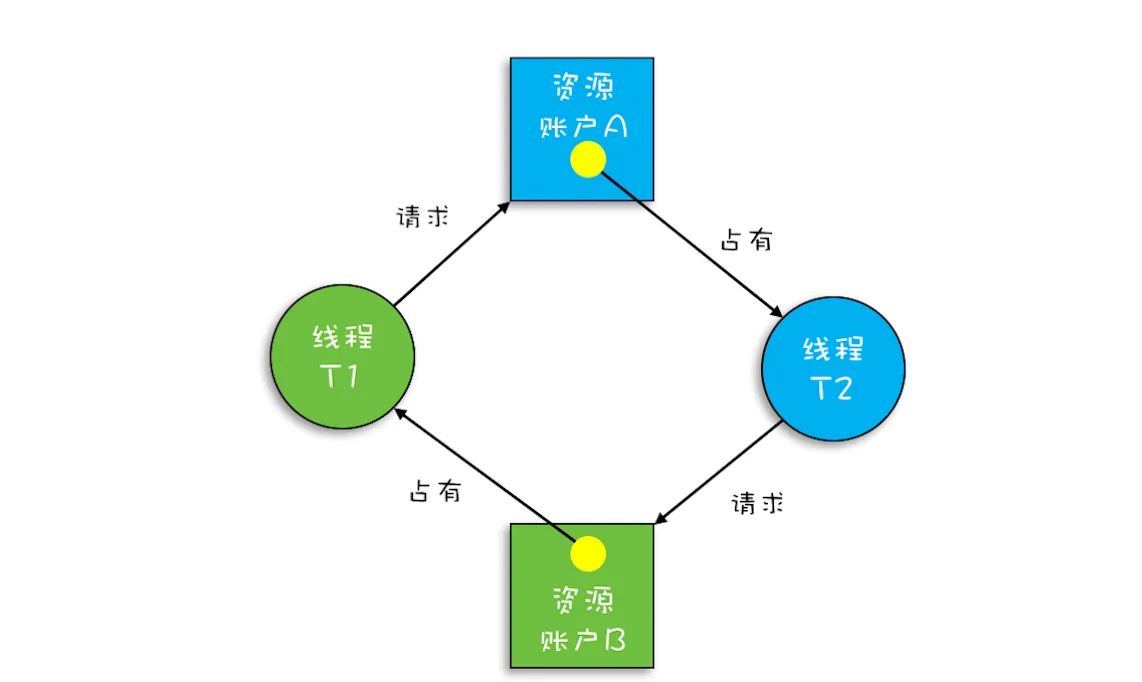前言
线程是轻量级的进程(LWP: light weight process),在 Linux 环境下线程的本质是进程。进程是资源分配的最小单位,线程是操作系统调度执行的最小单位。
进程
线程
线程比进程更加节省系统资源,效率更高。
每个线程都有属于自己的栈区和寄存器。
代码段、堆区、全局数据区和打开的文件(文件描述符表)是的线程共享的。
线程是程序的最小执行单位。
一个地址空间中可以划分出多个线程,在有效的资源基础上,能够抢更多的 CPU 时间片。
线程的上下文切换比进程要快的多。
线程更加廉价,启动速度更快,退出速度也快,对系统资源的冲击小。
进程和线程的分时复用 CPU 时间片时,在切换之前会将上一个任务的状态进行保存,下次切换回这个任务的时候,加载这个状态继续运行,任务从保存到再次加载这个过程是一次上下文切换。
在处理多任务时,使用线程比使用进程更有优势。
建议的线程数:
操作系统:Ubuntu 20.04.4 LTS
参考文档
苏丙榅老师的多线程教程
苏丙榅老师的线程同步教程
生产者消费者问题
创建线程
线程的 ID 类型为 pthread_t,本质是无符号长整型。
返回当前线程ID的函数
1 pthread_t pthread_self (void ) ;
创建线程的函数
1 2 #include <pthread.h> int pthread_create (pthread_t *thread, const pthread_attr_t *attr, void *(*start_routine)(void *), void *arg) ;
函数指针 start_routine 的类型为 void * (*start_routine)(void *)。
1 2 3 4 5 6 7 8 9 10 11 12 13 14 15 16 17 18 19 20 21 22 23 24 25 26 27 28 29 30 31 32 33 34 35 36 #include <stdio.h> #include <stdlib.h> #include <unistd.h> #include <string.h> #include <pthread.h> void * working (void * arg) { printf ("子线程,ID:%ld\n" , pthread_self()); for (int i = 0 ; i < 9 ; ++i) { printf ("child i = %d\n" , i); } return NULL ; } int main () { pthread_t tid; pthread_create(&tid, NULL , working, NULL ); printf ("子线程创建成功,ID:%ld\n" , tid); printf ("主线程,ID:%ld\n" , pthread_self()); for (int i = 0 ; i < 3 ; ++i) { printf ("main i = %d\n" , i); } sleep(1 ); return 0 ; }
线程的动态链接库为libpthread.so
1 2 3 gcc pthread_create.c -lpthread ./a.out
正常情况下,主线程控制虚拟地址空间(虚拟地址空间的生命周期和主线程相同),当主线程退出时,虚拟地址空间将被释放,因此子线程也将被销毁。但是子线程退出时,不会释放虚拟地址空间。
线程退出
线程退出函数,只会退出该线程,并不会释放虚拟地址空间(主线程)。
1 2 #include <pthread.h> void pthread_exit (void *retval) ;
retval: 线程退出时返回的数据,主线程会得到该子线程的该数据。如果没有返回的数据,retval 指定为 NULL。
1 2 3 4 5 6 7 8 9 10 11 12 13 14 15 16 17 18 19 20 21 22 23 24 25 26 27 28 29 30 31 32 33 34 35 36 37 38 39 40 41 42 #include <stdio.h> #include <stdlib.h> #include <unistd.h> #include <string.h> #include <pthread.h> void * working (void * arg) { sleep(1 ); printf ("子线程,ID:%ld\n" , pthread_self()); for (int i = 0 ; i < 9 ; ++i) { if (i == 6 ) { pthread_exit(NULL ); } printf ("child i = %d\n" , i); } return NULL ; } int main () { pthread_t tid; pthread_create(&tid, NULL , working, NULL ); printf ("子线程创建成功,ID:%ld\n" , tid); printf ("主线程,ID:%ld\n" , pthread_self()); for (int i = 0 ; i < 3 ; ++i) { printf ("main i = %d\n" , i); } pthread_exit(NULL ); return 0 ; }
线程回收
线程回收函数是 pthread_join(),该函数会阻塞当前线程(一般为主线程),直到要回收的子线程退出。可以通过该函数获得子线程退出时返回的数据。
1 2 #include <pthread.h> int pthread_join (pthread_t thread, void **retval)
数据保存在子线程的栈区
1 2 3 4 5 6 7 8 9 10 11 12 13 14 15 16 17 18 19 20 21 22 23 24 25 26 27 28 29 30 31 32 33 34 35 36 37 38 39 40 41 42 43 44 45 46 47 48 49 50 51 52 53 54 55 56 57 58 #include <stdio.h> #include <stdlib.h> #include <unistd.h> #include <string.h> #include <pthread.h> struct Person { int id; char name[36 ]; int age; }; void * working (void * arg) { printf ("子线程,ID:%ld\n" , pthread_self()); for (int i = 0 ; i < 9 ; ++i) { printf ("child i = %d\n" , i); if (i == 6 ) { struct Person p ; p.age = 12 ; strcpy (p.name, "susu" ); p.id = 1 ; pthread_exit(&p); } } return NULL ; } int main () { pthread_t tid; pthread_create(&tid, NULL , working, NULL ); printf ("子线程创建成功,ID:%ld\n" , tid); printf ("主线程,ID:%ld\n" , pthread_self()); for (int i = 0 ; i < 3 ; ++i) { printf ("main i = %d\n" , i); } void * ptr = NULL ; pthread_join(tid, &ptr); struct Person * pp =struct Person*)ptr; pritnf("子线程返回数据 name: %s, age: %d, id: %d\n" , pp->name, pp->age, pp->id); printf ("子线程资源被成功回收...\n" ); return 0 ; }
编译并执行程序
1 2 3 gcc pthread_join.c -lpthread ./a.out
运行结果显示主线程并没有获取子线程返回的数据,由于子线程的栈区的生命周期与子线程相同,因此当子线程退出后,子线程的栈区将被回收,主线程并不能得到子线程返回的栈区数据。
数据保存在全局变量中
位于同一个虚拟地址空间中的线程,可以共享全局数据区和堆区数据(全局变量、静态变量和堆内存)。
1 2 3 4 5 6 7 8 9 10 11 12 13 14 15 16 17 18 19 20 21 22 23 24 25 26 27 28 29 30 31 32 33 34 35 36 37 38 39 40 41 42 43 44 45 46 47 48 49 50 51 52 53 54 55 56 57 #include <stdio.h> #include <stdlib.h> #include <unistd.h> #include <string.h> #include <pthread.h> struct Person { int id; char name[36 ]; int age; }; struct Person p ;void * working (void * arg) { printf ("子线程,ID:%ld\n" , pthread_self()); for (int i = 0 ; i < 9 ; ++i) { printf ("child i = %d\n" , i); if (i == 6 ) { p.age = 12 ; strcpy (p.name, "susu" ); p.id = 1 ; pthread_exit(&p); } } return NULL ; } int main () { pthread_t tid; pthread_create(&tid, NULL , working, NULL ); printf ("子线程创建成功,ID:%ld\n" , tid); printf ("主线程,ID:%ld\n" , pthread_self()); for (int i = 0 ; i < 3 ; ++i) { printf ("main i = %d\n" , i); } void * ptr = NULL ; pthread_join(tid, &ptr); struct Person * pp =struct Person*)ptr; pritnf("子线程返回数据 name: %s, age: %d, id: %d\n" , pp->name, pp->age, pp->id); printf ("子线程资源被成功回收...\n" ); return 0 ; }
数据保存在主线程栈区中
1 2 3 4 5 6 7 8 9 10 11 12 13 14 15 16 17 18 19 20 21 22 23 24 25 26 27 28 29 30 31 32 33 34 35 36 37 38 39 40 41 42 43 44 45 46 47 48 49 50 51 52 53 54 55 56 57 58 #include <stdio.h> #include <stdlib.h> #include <unistd.h> #include <string.h> #include <pthread.h> struct Person { int id; char name[36 ]; int age; }; void * working (void * arg) { struct Person * p =struct Person*)arg; printf ("子线程,ID:%ld\n" , pthread_self()); for (int i = 0 ; i < 9 ; ++i) { printf ("child i = %d\n" , i); if (i == 6 ) { p->age = 12 ; strcpy (p->name, "susu" ); p->id = 1 ; pthread_exit(p); } } return NULL ; } int main () { pthread_t tid; struct Person p ; pthread_create(&tid, NULL , working, &p); printf ("子线程创建成功,ID:%ld\n" , tid); printf ("主线程,ID:%ld\n" , pthread_self()); for (int i = 0 ; i < 3 ; ++i) { printf ("main i = %d\n" , i); } void * ptr = NULL ; pthread_join(tid, &ptr); pritnf("子线程返回数据 name: %s, age: %d, id: %d\n" , p.name, p.age, p.id); printf ("子线程资源被成功回收...\n" ); return 0 ; }
线程分离
线程分离函数 pthread_detach() 可以使子线程和主线程分离,子线程退出时会被其他进程回收。
1 2 #include <pthread.h> int pthread_detach (pthread_t thread) ;
主线程和子线程的分离
1 2 3 4 5 6 7 8 9 10 11 12 13 14 15 16 17 18 19 20 21 22 23 24 25 26 27 28 29 30 31 32 33 34 35 36 37 #include <stdio.h> #include <stdlib.h> #include <unistd.h> #include <string.h> #include <pthread.h> void * working (void * arg) { printf ("字线程,ID:%ld\n" , pthread_self()); for (int i = 0 ; i < 9 ; ++i) { printf ("child i = %d\n" , i); } return NULL ; } int main () { pthread_t tid; pthread_create(&tid, NULL , working, NULL ); printf ("子线程创建成功,ID:%ld\n" , tid); printf ("主线程,ID:%ld\n" , pthread_self()); for (int i = 0 ; i < 3 ; ++i) { printf ("main i = %d\n" , i); } pthread_detach(tid); pthread_exit(NULL ); return 0 ; }
线程取消
线程取消函数 pthread_cancel 可以使一个线程 kill 另一个线程。下面是 kill 一个线程的步骤:
线程 A 中调用线程取消函数 pthread_cancel,指定杀死线程 B。
线程 B 调用一次系统调用(内核函数即系统函数)。
线程 B 被 kill。
1 2 #include <pthread.h> int pthread_cancel (pthread_t thread) ;
thread: 要 kill 的线程的 ID。
返回值: 函数调用成功返回 0。
1 2 3 4 5 6 7 8 9 10 11 12 13 14 15 16 17 18 19 20 21 22 23 24 25 26 27 28 29 30 31 32 33 34 35 36 37 38 39 40 41 42 43 44 #include <stdio.h> #include <stdlib.h> #include <unistd.h> #include <string.h> #include <pthread.h> void * working (void * arg) { int j = 0 ; for (int i = 0 ; i < 9 ; ++i) { j++; } printf ("子线程,ID:%ld\n" , pthread_self()); for (int i = 0 ; i < 9 ; ++i) { printf ("child i = %d\n" , i); } return NULL ; } int main () { pthread_t tid; pthread_create(&tid, NULL , working, NULL ); printf ("子线程创建成功,ID:%ld\n" , tid); printf ("主线程,ID:%ld\n" , pthread_self()); for (int i = 0 ; i < 3 ; ++i) { printf ("main i = %d\n" , i); } pthread_cancel(tid); pthread_exit(NULL ); return 0 ; }
系统调用的两种方式:
直接调用 Linux 系统函数。
调用 C 语言的标准库函数。
线程 ID 比较
线程 ID 的类型本质是无符号长整型,因此可以直接用比较运算符比较。也可以使用 线程 ID 比较函数 比较。
1 2 #include <pthread.h> int pthread_equal (pthread_t t1, pthread_t t2) ;
t1 和 t2: 要比较的线程 ID。
返回值: 相等返回非 0 值,不相等返回 0。
线程同步
线程同步保证多个线程只能有一个线程在访问共享资源。保证共享资源对于所有线程具有一致性。
不进行线程同步
1 2 3 4 5 6 7 8 9 10 11 12 13 14 15 16 17 18 19 20 21 22 23 24 25 26 27 28 29 30 31 32 33 34 35 36 37 38 39 40 41 42 43 44 45 46 47 48 49 50 51 52 #include <stdio.h> #include <unistd.h> #include <stdlib.h> #include <sys/types.h> #include <sys/stat.h> #include <string.h> #include <pthread.h> #define MAX 50 int number;void * funcA_num (void * arg) { for (int i = 0 ; i < MAX; ++i) { int cur = number; cur++; usleep(10 ); number = cur; printf ("Thread A, id = %lu, number = %d\n" , pthread_self(), number); } return NULL ; } void * funcB_num (void * arg) { for (int i = 0 ; i < MAX; ++i) { int cur = number; cur++; number = cur; printf ("Thread B, id = %lu, number = %d\n" , pthread_self(), number); usleep(5 ); } return NULL ; } int main (int argc, const char * argv[]) { pthread_t p1, p2; pthread_create(&p1, NULL , funcA_num, NULL ); pthread_create(&p2, NULL , funcB_num, NULL ); pthread_join(p1, NULL ); pthread_join(p2, NULL ); return 0 ; }
编译并执行上面代码,可以发现最终的 number 小于 100。
CPU 的寄存器、一级缓存、二级缓存和三级缓存对于每个线程是独占的,用于存储处理的数据和线程的状态信息,即分时复用 CPU 时间片时上下文切换保存的状态。线程计算完成的数据需要从 CPU 保存到内存中,最终再通过文件 IO 将数据从内存保存到磁盘中。
当某一个线程未将某一循环中计算完成的数据保存到内存中时,失去了 CPU 时间片。另一个得到 CPU 时间片的线程从物理内存读取数据。因此这个线程只能基于旧数据计算,并将计算后的数据保存到内存中,然后继续循环计算,直到这个线程失去了 CPU 时间片。由于我们上面的例子中只有两个线程,上一个失去CPU 时间片获得 CPU 时间片,将还未来得及保存到内存的数据保存到内存中,覆盖了另一个线程保存的数据。因此导致最终的 number 小于 100。
线程同步共有 4 种,互斥锁 、读写锁 、条件变量 和 信号量 。共享资源被称为临界资源。临界资源相关的上下文代码块被称为临界区。
线程同步:需要在临界区上边添加锁函数,对临界区加锁;在临界区下边添加解锁函数,对临界区解锁。某一线程会将临界区锁定,防止其他线程和它同时访问临界区,等到它访问完成,对临界区解锁,其他被阻塞且抢到锁的线程对临界区加锁,访问临界区。
锁机制保证任何时刻只能有一个线程可以访问临界区。
互斥锁
互斥锁的类型为 pthread_mutex_t。该类型保存了锁的状态:锁定还是未锁定;加锁的线程 ID。一个互斥锁只能被一个线程锁定,其他想对临界区加锁的线程将被阻塞。直到这把互斥锁被加锁的线程解锁,被阻塞的线程才能解除阻塞。互斥锁的数量和共享资源的个数相同。
只有 restrict 修饰的指针可以访问该地址。
1 2 3 4 5 int pthread_mutex_init (pthread_mutex_t *restrict mutex, const pthread_mutexattr_t *restrict attr) ;int pthread_mutex_destroy (pthread_mutex_t *mutex) ;
mutex: 互斥锁变量的地址。
attr: 互斥锁的属性,一般为 NULL。
1 2 int pthread_mutex_lock (pthread_mutex_t *mutex) ;
1 2 3 int pthread_mutex_trylock (pthread_mutex_t *mutex) ;
1 2 int pthread_mutex_unlock (pthread_mutex_t *mutex) ;
进行线程同步
1 2 3 4 5 6 7 8 9 10 11 12 13 14 15 16 17 18 19 20 21 22 23 24 25 26 27 28 29 30 31 32 33 34 35 36 37 38 39 40 41 42 43 44 45 46 47 48 49 50 51 52 53 54 55 56 57 58 59 60 61 62 #include <stdio.h> #include <unistd.h> #include <stdlib.h> #include <sys/types.h> #include <sys/stat.h> #include <string.h> #include <pthread.h> #define MAX 50 int number;pthread_mutex_t mutex;void * funcA_num (void * arg) { for (int i = 0 ; i < MAX; ++i) { pthread_mutex_lock(&mutex); int cur = number; cur++; usleep(10 ); number = cur; pthread_mutex_unlock(&mutex); printf ("Thread A, id = %lu, number = %d\n" , pthread_self(), number); } return NULL ; } void * funcB_num (void * arg) { for (int i = 0 ; i < MAX; ++i) { pthread_mutex_lock(&mutex); int cur = number; cur++; number = cur; pthread_mutex_unlock(&mutex); printf ("Thread B, id = %lu, number = %d\n" , pthread_self(), number); usleep(5 ); } return NULL ; } int main () (int argc, const char * argv[]) { pthread_t p1, p2; pthread_mutex_init(&mutex, NULL ); pthread_create(&p1, NULL , funcA_num, NULL ); pthread_create(&p2, NULL , funcB_num, NULL ); pthread_join(p1, NULL ); pthread_join(p2, NULL ); pthread_mutex_destroy(&mutex); return 0 ; }
死锁
死锁现象:所有的线程都被阻塞,并且所有线程的阻塞都无法解开(解锁的线程也被阻塞了)。
死锁现象1——加锁之后忘记解锁
1 2 3 4 5 6 7 void func () { for (int i = 0 ; i < 6 ; ++i) { pthread_mutex_lock(&mutex); } }
1 2 3 4 5 6 7 8 9 10 11 12 13 14 void func () { for (int i = 0 ; i < 6 ; ++i) { pthread_mutex_lock(&mutex); if (condition) { return ; } pthread_mutex_unlock(&mutex); } }
死锁现象2——重复加锁
1 2 3 4 5 6 7 8 9 10 11 void func () { for (int i = 0 ; i < 6 ; ++i) { pthread_mutex_lock(&mutex); pthread_mutex_lock(&mutex); pthread_mutex_unlock(&mutex); } }
1 2 3 4 5 6 7 8 9 10 11 12 13 14 15 16 17 18 19 20 21 void funcA () { for (int i = 0 ; i < 6 ; ++i) { pthread_mutex_lock(&mutex); pthread_mutex_unlock(&mutex); } } void funcB () { for (int i = 0 ; i < 6 ; ++i) { pthread_mutex_lock(&mutex); funcA(); pthread_mutex_unlock(&mutex); } }
死锁现象3——多个共享资源,多个线程,随意加锁
避免死锁
避免多次锁定。
对共享资源访问完毕之后,一定要解锁。
控制多个共享资源访问顺序,即控制加锁解锁顺序。
对其他互斥锁加锁前,先释放拥有的互斥锁。
读写锁
读写锁是互斥锁的升级版,读操作是并行的。读写锁的类型为 pthread_rwlock_t。该类型包含以下信息:锁定 / 打开、读操作 / 写操作 和 线程 ID。
1 pthread_rwlock_t rwlock;
读写锁 锁定了 读操作,需要先解锁才能去锁定写操作,反之亦然。
读写锁的使用方式和互斥锁的使用方式完全相同。
使用读写锁的读锁锁定了临界区,线程对临界区的访问是并行的,读锁是共享的。
使用读写锁的写锁锁定了临界区,线程对临界区的访问是串行的,写锁是独占的。
两个线程要同时访问读锁和写锁锁定的两个临界区。访问写锁锁定的临界区线程先访问,访问读锁锁定的临界区的线程被阻塞。写锁的优先级更高。
读写锁对读操作比写操作多的场景有优势。
1 2 3 4 5 6 7 8 #include <pthread.h> pthread_rwlock_t rwlock;int pthread_rwlock_init (pthread_rwlock_t *restrict rwlock, const pthread_rwlockattr_t *restrict attr) ;int pthread_rwlock_destroy (pthread_rwlock_t *rwlock) ;
rwlock: 读写锁变量的地址。
attr: 读写锁的属性,一般为 NULL。
1 2 int pthread_rwlock_rdlock (pthread_rwlock_t *rwlock) ;
1 2 int pthread_rwlock_tryrdlock (pthread_rwlock_t *rwlock) ;
1 2 int pthread_rwlock_wrlock (pthread_rwlock_t *rwlock) ;
1 2 int pthread_rwlock_trywrlock (pthread_rwlock_t *rwlock) ;
1 2 int pthread_rwlock_unlock (pthread_rwlock_t *rwlock) ;
读写锁的使用
1 2 3 4 5 6 7 8 9 10 11 12 13 14 15 16 17 18 19 20 21 22 23 24 25 26 27 28 29 30 31 32 33 34 35 36 37 38 39 40 41 42 43 44 45 46 47 48 49 50 51 52 53 54 55 56 57 58 59 60 61 62 63 64 65 66 67 68 69 70 #include <stdio.h> #include <stdlib.h> #include <unistd.h> #include <string.h> #include <pthread.h> int number = 0 ;pthread_rwlock_t rwlock;void * writeNum (void * arg) { while (1 ) { pthread_rwlock_wrlock(&rwlock); int cur = number; cur++; number = cur; printf ("写操作完毕,number = %d, tid = %ld\n" , number, pthread_self()); pthread_rwlock_unlock(&rwlock); usleep(rand() % 100 ); } return NULL ; } void * readNum (void * arg) { while (1 ) { pthread_rwlock_rdlock(&rwlock); printf ("读操作完毕,number = %d, tid = %ld\n" , number, pthread_self()); pthread_rwlock_unlock(&rwlock); usleep(rand() % 100 ); } return NULL ; } int main () { pthread_rwlock_init(&rwlock, NULL ); pthread_t wtid[3 ]; pthread_t rtid[5 ]; for (int i = 0 ; i < 3 ; ++i) { pthread_create(&wtid[i], NULL , writeNum, NULL ); } for (int i = 0 ; i < 5 ; ++i) { pthread_create(&rtid[i], NULL , readNum, NULL ); } for (int i = 0 ; i < 3 ; ++i) { pthread_join(wtid[i], NULL ); } for (int i = 0 ; i < 5 ; ++i) { pthread_join(rtid[i], NULL ); } pthread_rwlock_destroy(&rwlock); return 0 ; }
条件变量
条件变量
条件变量在满足条件时会阻塞线程。条件变量配合互斥锁用于处理生产者和消费者模型。
条件变量类型为 pthread_cond_t,被条件变量阻塞的线程的信息被记录在这个类型变量中。
1 2 3 4 5 6 7 8 #include <pthread.h> pthread_cond_t cond;int pthread_cond_init (pthread_cond_t *restrict cond, const pthread_condattr_t *restrict attr) ;int pthread_cond_destroy (pthread_cond_t *cond) ;
cond: 条件变量的地址。
attr: 条件变量的属性,一般为 NULL。
1 2 int pthread_cond_wait (pthread_cond_t *restrict cond, pthread_mutex_t *restrict mutex) ;
pthread_cond_wait 函数的作用可以参考下面例子(生产者和消费者问题)中的消费者线程函数(consumer函数)。
在 阻塞消费者线程 时候(内层的while循环),该函数会把当前消费者线程之前上的锁 mutex 打开。
当 消费者线程解除阻塞 时候,该函数会帮助这个消费者线程将这个 mutex 互斥锁再次锁上。消费者线程继续访问临界区。
1 2 3 4 5 6 7 8 9 10 11 12 struct timespec { time_t tv_sec; long tv_nsec; }; int pthread_cond_timedwait (pthread_cond_t *restrict cond, pthread_mutex_t *restrict mutex, const struct timespec *restrict abstime) ;
1 2 3 4 5 6 7 8 time_t mytime = time(NULL );struct timespec tmsp ;tmsp.tv_sec = time(NULL ) + 100 ; tmsp.tv_nsec = 0 ;
1 2 3 4 5 int pthread_cond_signal (pthread_cond_t *cond) ;int pthread_cond_broadcast (pthread_cond_t *cond) ;
生产者和消费者问题
生产者消费者问题(英语:Producer-consumer problem),也称有限缓冲问题(英语:Bounded-buffer problem),是一个多线程同步问题的经典案例。该问题描述了两个共享固定大小缓冲区的线程——即所谓的“生产者”和“消费者”——在实际运行时会发生的问题。生产者的主要作用是生成一定量的数据放到缓冲区中,然后重复此过程。与此同时,消费者也在缓冲区消耗这些数据。该问题的关键就是要保证生产者不会在缓冲区满时加入数据,消费者也不会在缓冲区中空时消耗数据。该问题也能被推广到多个生产者和消费者的情形。
场景描述:使用条件变量和互斥锁实现生产者和消费者模型,生产者和消费者各 5 个,生产者在链表头部添加节点;消费者在链表头部删除节点。由于缓存区是链表,所以生产者可以一直生产。
1 2 3 4 5 6 7 8 9 10 11 12 13 14 15 16 17 18 19 20 21 22 23 24 25 26 27 28 29 30 31 32 33 34 35 36 37 38 39 40 41 42 43 44 45 46 47 48 49 50 51 52 53 54 55 56 57 58 59 60 61 62 63 64 65 66 67 68 69 70 71 72 73 74 75 76 77 78 79 80 81 82 83 84 85 86 87 88 89 90 91 92 93 94 95 96 97 98 99 100 101 #include <stdio.h> #include <stdlib.h> #include <unistd.h> #include <string.h> #include <pthread.h> struct Node { int number; struct Node * next ; }; pthread_cond_t cond;pthread_mutex_t mutex;struct Node * head =NULL ;void * producer (void * arg) { while (1 ) { pthread_mutex_lock(&mutex); struct Node * pnew =struct Node*)malloc (sizeof (struct Node)); pnew->number = rand() % 1000 ; pnew->next = head; head = pnew; printf ("producer, number = %d, tid = %ld\n" , pnew->number, pthread_self()); pthread_mutex_unlock(&mutex); pthread_cond_broadcast(&cond); sleep(rand() % 3 ); } return NULL ; } void * consumer (void * arg) { while (1 ) { pthread_mutex_lock(&mutex); while (head == NULL ) { pthread_cond_wait(&cond, &mutex); } struct Node * pnode = printf ("consumer, number = %d, tid = %ld\n" , pnode->number, pthread_self()); head = pnode->next; free (pnode); pthread_mutex_unlock(&mutex); sleep(rand() % 3 ); } return NULL ; } int main () { pthread_cond_init(&cond, NULL ); pthread_mutex_init(&mutex, NULL ); pthread_t ptid[5 ]; pthread_t ctid[5 ]; for (int i = 0 ; i < 5 ; ++i) { pthread_create(&ptid[i], NULL , producer, NULL ); } for (int i = 0 ; i < 5 ; ++i) { pthread_create(&ctid[i], NULL , consumer, NULL ); } for (int i = 0 ; i < 5 ; ++i) { pthread_join(ptid[i], NULL ); } for (int i = 0 ; i < 5 ; ++i) { pthread_join(ctid[i], NULL ); } pthread_cond_destroy(&cond); pthread_mutex_destroy(&mutex); return 0 ; }
信号量
信号量 如它的名字一样可以指示资源的可用情况,它配合互斥锁也可以处理生产者和消费者模型,它也被称为 信号灯。
使用信号量需要引用头文件 <semaphore.h>。信号量的类型为 sem_t。
1 2 #include <semaphore.h> sem_t sem;
1 2 3 4 5 6 7 #include <semaphore.h> int sem_init (sem_t *sem, int pshared, unsigned int value) ;int sem_destroy (sem_t *sem) ;
1 2 int sem_wait (sem_t *sem) ;
线程调用 sem_wait 函数,如果资源数 >0,线程不会被阻塞,资源数 -1;如果资源数 =0,线程被阻塞。
1 2 int sem_trywait (sem_t *sem) ;
1 2 3 4 5 6 7 8 9 10 11 12 struct timespec { time_t tv_sec; long tv_nsec; }; int sem_timedwait (sem_t *sem, const struct timespec *abs_timeout) ;
1 2 int sem_post (sem_t *sem) ;
1 2 int sem_getvalue (sem_t *sem, int *sval) ;
生产者和消费者问题
场景描述:使用信号量和互斥锁实现生产者和消费者模型,生产者和消费者各 5 个,生产者在链表头部添加节点;消费者在链表头部删除节点。
总资源数为1
由于生产者和消费者的总资源数为 1,所以任何时刻可以工作的线程只能有一个,不需要互斥锁。
1 2 3 4 5 6 7 8 9 10 11 12 13 14 15 16 17 18 19 20 21 22 23 24 25 26 27 28 29 30 31 32 33 34 35 36 37 38 39 40 41 42 43 44 45 46 47 48 49 50 51 52 53 54 55 56 57 58 59 60 61 62 63 64 65 66 67 68 69 70 71 72 73 74 75 76 77 78 79 80 81 82 83 84 85 86 87 88 89 90 91 92 93 94 95 96 97 98 99 #include <stdio.h> #include <stdlib.h> #include <unistd.h> #include <string.h> #include <semaphore.h> #include <pthread.h> struct Node { int number; struct Node * next ; }; sem_t psem;sem_t csem;pthread_mutex_t mutex;struct Node * head =NULL ;void * producer (void * arg) { while (1 ) { sem_wait(&psem); struct Node * pnew =struct Node*)malloc (sizeof (struct Node)); pnew->number = rand() % 1000 ; pnew->next = head; head = pnew; printf ("producer, number = %d, tid = %ld\n" , pnew->number, pthread_self()); sem_post(&csem); sleep(rand() % 3 ); } return NULL ; } void * consumer (void * arg) { while (1 ) { sem_wait(&csem); struct Node * pnode = printf ("consumer, number = %d, tid = %ld\n" , pnode->number, pthread_self()); head = pnode->next; free (pnode); sem_post(&psem); sleep(rand() % 3 ); } return NULL ; } int main () { sem_init(&psem, 0 , 1 ); sem_init(&csem, 0 , 0 ); pthread_t ptid[5 ]; pthread_t ctid[5 ]; for (int i = 0 ; i < 5 ; ++i) { pthread_create(&ptid[i], NULL , producer, NULL ); } for (int i = 0 ; i < 5 ; ++i) { pthread_create(&ctid[i], NULL , consumer, NULL ); } for (int i = 0 ; i < 5 ; ++i) { pthread_join(ptid[i], NULL ); } for (int i = 0 ; i < 5 ; ++i) { pthread_join(ctid[i], NULL ); } sem_destroy(&psem); sem_destroy(&csem); return 0 ; }
总资源数大于1
由于生产者和消费者的总资源数大于 1,所以需要互斥锁。信号量和互斥锁的函数在线程函数( producer 和 consumer )中调用顺序不能颠倒。
1 2 3 4 5 6 7 8 9 10 11 12 13 14 15 16 17 18 19 20 21 22 23 24 25 26 27 28 29 30 31 32 33 34 35 36 37 38 39 40 41 42 43 44 45 46 47 48 49 50 51 52 53 54 55 56 57 58 59 60 61 62 63 64 65 66 67 68 69 70 71 72 73 74 75 76 77 78 79 80 81 82 83 84 85 86 87 88 89 90 91 92 93 94 95 96 97 98 99 100 101 102 103 104 105 106 107 108 109 110 111 112 #include <stdio.h> #include <stdlib.h> #include <unistd.h> #include <string.h> #include <semaphore.h> #include <pthread.h> struct Node { int number; struct Node * next ; }; sem_t psem;sem_t csem;pthread_mutex_t mutex;struct Node * head =NULL ;void * producer (void * arg) { while (1 ) { sem_wait(&psem); pthread_mutex_lock(&mutex); struct Node * pnew =struct Node*)malloc (sizeof (struct Node)); pnew->number = rand() % 1000 ; pnew->next = head; head = pnew; printf ("producer, number = %d, tid = %ld\n" , pnew->number, pthread_self()); pthread_mutex_unlock(&mutex); sem_post(&csem); sleep(rand() % 3 ); } return NULL ; } void * consumer (void * arg) { while (1 ) { sem_wait(&csem); pthread_mutex_lock(&mutex); struct Node * pnode = printf ("consumer, number = %d, tid = %ld\n" , pnode->number, pthread_self()); head = pnode->next; free (pnode); pthread_mutex_unlock(&mutex); sem_post(&psem); sleep(rand() % 3 ); } return NULL ; } int main () { sem_init(&psem, 0 , 5 ); sem_init(&csem, 0 , 0 ); pthread_mutex_init(&mutex, NULL ); pthread_t ptid[5 ]; pthread_t ctid[5 ]; for (int i = 0 ; i < 5 ; ++i) { pthread_create(&ptid[i], NULL , producer, NULL ); } for (int i = 0 ; i < 5 ; ++i) { pthread_create(&ctid[i], NULL , consumer, NULL ); } for (int i = 0 ; i < 5 ; ++i) { pthread_join(ptid[i], NULL ); } for (int i = 0 ; i < 5 ; ++i) { pthread_join(ctid[i], NULL ); } sem_destroy(&psem); sem_destroy(&csem); pthread_mutex_destroy(&mutex); return 0 ; }
结语
第十四篇博文写完,开心!!!!
今天,也是充满希望的一天。






.png)









